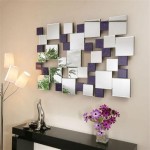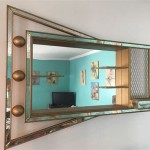Why Convex Mirrors Are Used in Vehicles for Rear View
Convex mirrors are a crucial safety feature in vehicles, providing drivers with an expanded view of the area behind them. Their unique curvature allows them to reflect light outwards, offering a wider field of vision compared to a flat or concave mirror. This characteristic is particularly important for maneuvering, changing lanes, and parking, where awareness of surrounding vehicles and obstacles is paramount.
Key Advantages of Convex Mirrors
Several key advantages contribute to the widespread use of convex mirrors in vehicles:
Wider Field of View
The most significant benefit of a convex mirror is its ability to capture a broader field of view. The outward curve distorts the reflected image, shrinking distant objects and widening the observable area. This allows drivers to see more of the road and traffic behind them, reducing blind spots and enhancing overall awareness.
Reduced Blind Spots
Blind spots are areas around a vehicle that are not visible to the driver through the standard mirrors or direct line of sight. Convex mirrors, with their wider field of vision, help minimize these blind spots, allowing drivers to spot vehicles or obstacles that might otherwise be missed.
Enhanced Safety during Maneuvers
Whether reversing, changing lanes, or navigating tight spaces, convex mirrors offer crucial visual information. The expanded field of view allows drivers to see approaching vehicles, pedestrians, and other obstacles more effectively, facilitating safer and more controlled maneuvers.
Cost-Effectiveness
Convex mirrors are relatively inexpensive to manufacture and install, making them a cost-effective safety solution for vehicles. Their simplicity and durability further contribute to their widespread adoption.
Understanding the Image Distortion
While the wider field of view offered by convex mirrors is advantageous, it's essential to understand the image distortion they produce. Objects reflected in a convex mirror appear smaller and farther away than they actually are. This distortion is a direct result of the mirror's outward curve and how it reflects light. Drivers must learn to interpret this distortion accurately to judge distances and speeds effectively.
Key Considerations for Using Convex Mirrors
Effective use of convex mirrors requires understanding their limitations and adapting driving habits accordingly.
Judging Distance and Speed
As mentioned previously, objects in a convex mirror appear smaller and farther away than they are in reality. Drivers need to compensate for this distortion when judging the distance and speed of approaching vehicles. Experience and careful observation are crucial for accurate interpretation.
Combined Use with Other Mirrors
Convex mirrors should be used in conjunction with the vehicle's other mirrors—the driver-side and passenger-side mirrors—to gain a comprehensive view of the surroundings. Relying solely on the convex mirror can lead to misjudgments due to the image distortion.
Regular Adjustment and Maintenance
Like any vehicle component, convex mirrors require periodic adjustment and maintenance. Ensure the mirror is positioned correctly to maximize its effectiveness and check for any damage or deterioration that might impair visibility.
Legal Requirements and Regulations
The use of convex mirrors is often mandated by law in many jurisdictions, particularly for larger vehicles like trucks and buses. These regulations recognize the crucial safety benefits of convex mirrors in reducing blind spots and enhancing overall visibility. Specific requirements regarding the size, placement, and type of convex mirrors may vary by region.
Key Regulations Concerning Convex Mirrors
Regulations often specify details such as the minimum size of the convex mirror, its required position on the vehicle, and specific labeling requirements to inform the driver about the image distortion. These regulations aim to standardize the use of convex mirrors and ensure they provide the intended safety benefits.
Convex Mirrors and Driver Education
Driver education programs should emphasize the importance of understanding and correctly using convex mirrors. Training should cover topics such as interpreting the image distortion, judging distance and speed accurately, and combining the use of convex mirrors with other mirrors for a comprehensive view of the surroundings.
Key Elements of Driver Training
Effective driver training should incorporate practical exercises to help drivers adapt to the distorted image in convex mirrors and accurately judge distances. Simulations and on-road practice can reinforce these skills, contributing to safer driving habits.
Technological Advancements in Rear View Systems
While traditional convex mirrors remain a critical safety feature, advancements in automotive technology are introducing new rear-view systems. These systems often incorporate cameras and digital displays to provide drivers with an even wider and clearer view of the area behind the vehicle.
Key Technological Advancements
These advancements include camera-based systems that eliminate blind spots entirely, digital displays that offer a panoramic view of the rear, and systems that integrate with other driver-assistance features like lane departure warnings and blind spot monitoring. These technologies continue to evolve, promising further enhancements to vehicle safety and driver awareness.

Why Do We Prefer Convex Mirror As A Rear View In Vehicles Class 10 Ch Light Physics

Convex Mirrors Use Car

Important Question Why Convex Mirror Is Used As Rear View In Vehicles

Why Is Convex Mirror Used As Rear View In Motor Vehicles Brainly

Why Do We Prefer A Convex Mirror As Rear View In Vehicles

Convex And Concave Mirrors In Cars
In Trucks Cars Buses Side View Mirrors Are Convex But Center Rear Mirror Is Or Plane Quora

Concave Vs Convex Mirrors In Cars
Why Is A Convex Mirror Preferred For Use As Driving Over Plane Quora

Which Mirror Is Used For Rear View Image And Why Describe With Ray Diagram Edurev Class 10 Question








